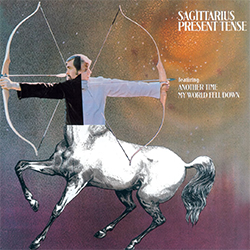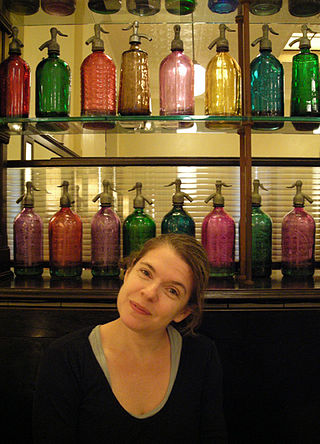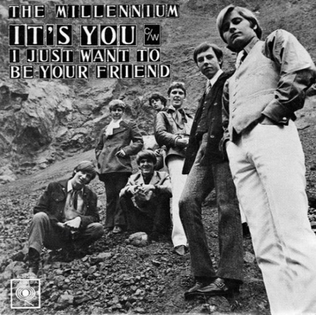
Curtis Roy Boettcher, sometimes credited as Curt Boetcher or Curt Becher, was an American singer, songwriter, arranger, musician, and record producer from Wisconsin. He was a pivotal figure in what is now termed "sunshine pop", working with the Association, the Millennium, Sagittarius, Paul Revere and the Raiders, Tommy Roe, Bobby Jameson, Elton John, Gene Clark, Emitt Rhodes, Tandyn Almer, the Beach Boys, and others.
Sunshine pop is a subgenre of pop music that originated in Southern California in the mid-1960s. Rooted in easy listening and advertising jingles, sunshine pop acts combined nostalgic or anxious moods with "an appreciation for the beauty of the world". The category largely consists of lesser-known artists who imitated more popular groups such as the Mamas & the Papas and the 5th Dimension. While the Beach Boys are noted as prominent influences, the band's music was rarely representative of the genre.

The Music Machine was an American rock band formed in Los Angeles, California in 1966. Fronted by chief songwriter and lead vocalist Sean Bonniwell, the band cultivated a dark and rebellious image reflected in their musical approach. Sometimes the band made use of distorted guitar lines and hallucinogenic organ parts, punctuated by Bonniwell's distinctively throaty vocals.
Doug Rhodes is an American multi-instrumentalist who performed with 1960s rock bands the Music Machine and the Millennium.
The Millennium were an American sunshine pop band formed in Los Angeles, California, in 1967.
William George "Lee" Mallory was a singer, songwriter and guitarist who was part of bands including The Millennium and Sagittarius. His most successful single was a cover of the Phil Ochs/Bob Gibson song "That's the Way It's Gonna Be". The song, produced by Curt Boettcher, reached No. 86 on the charts and was a surprise hit in Seattle. A CD by the same name was released in 2002, with many songs and demos Mallory had recorded during the 1960s. Lee Mallory helped start the California Sound of the 1960s.

Graham Salisbury is an American children's writer. His best known work is Under the Blood Red Sun, a historical novel that features a Japanese-American boy and his family during World War II. Under the name Sandy Salisbury he was a pop musician in the late 1960s, notably with The Millennium.
Michael Fennelly is an American musician known for his work as a singer and songwriter in the 1960s and 1970s, notably in The Millennium and Crabby Appleton.
Sagittarius was an American sunshine pop studio group formed in 1967, devised by record producer and songwriter Gary Usher.

Magic Time is an extensive three-disc compilation album containing music from the sunshine pop bands The Millennium, The Ballroom and Sagittarius and the artist Curt Boettcher. It was released in 2001.

Sandy was originally recorded in 1969 for Gary Usher's Together Records, a venture that was brief enough that the label collapsed before the album could be released.
The Goldebriars were an American folk quartet in the early 1960s, most notable for including a young Curt Boettcher as a guitarist and vocalist. The group also included two sisters, Dotti and Sheri Holmberg, with Ron Neilson as lead guitarist and banjo player.

Present Tense is the first Sagittarius album, released in 1968 by Columbia Records. Though the record was basically a Gary Usher solo project, he enlisted many top LA session musicians, and heavily utilized Curt Boettcher as a songwriter, musician, vocalist, and producer. The album also contains the recording "My World Fell Down", which had no Boettcher involvement, albeit the LP version was edited, with the musique concrète bridge from the single version being excised. The single "Hotel Indiscreet" also had a similar fate when it reached the LP.
Tandyn Douglas Almer was an American songwriter, musician, and record producer who wrote the 1966 song "Along Comes Mary" for the Association. He also wrote, co-wrote, and produced numerous other songs performed by artists such as the Beach Boys, the Purple Gang, the Garden Club, and Dennis Olivieri. In the early 1970s, he was a close friend and collaborator of Brian Wilson, co-writing the Beach Boys' singles "Marcella" (1972) and "Sail On, Sailor" (1973).
Sonic Past Music is a record label in Southern California that specializes in releasing previously unpublished music from mainstream artists. Most of the music from the label is from artists from the 1960s and 1970s sunshine pop, psychedelic pop era.

And Then... Along Comes the Association is the debut studio album by the Association, released on Valiant Records in July 1966. It became one of the top-selling albums in America, peaking at number five, and remains the Association's most successful album release, except for their Greatest Hits compilation. The album's success was primarily credited to the inclusion of their two U.S. hits "Along Comes Mary" and "Cherish", which peaked at number seven and number one respectively on the Billboard Hot 100; "Cherish" was number one on Billboard's Top 40 list for three weeks starting on September 24, 1966.

Elizabeth Sorrentino is an American pianist and singer-songwriter from Lancaster, Pennsylvania. She lives in Los Angeles.

Preflyte is a compilation album by the American folk rock band the Byrds and was released in July 1969 on Together Records. The album is a collection of demos recorded by the Byrds at World Pacific Studios in Los Angeles during late 1964, before the band had signed to Columbia Records and become famous. It includes early demo versions of the songs "Here Without You", "You Won't Have to Cry", "I Knew I'd Want You", and "Mr. Tambourine Man", all of which appeared in re-recorded form on the band's 1965 debut album.
"My World Fell Down" is a song written by John Carter and Geoff Stephens, and first recorded by the English pop rock band the Ivy League, on Pye Records, in 1966. The song was covered a year later by the American sunshine pop group Sagittarius, whose version charted on the Billboard Hot 100. Sagittarius's version of the composition has remained highly sought after among record collectors for its close resemblance to the Pet Sounds-era Beach Boys.

"It's You" is a song by the American sunshine pop band the Millennium, featured on their 1968 album Begin. Written by Michael Fennelly and Joey Stec, the song was produced by band leader Curt Boettcher and Keith Olsen. A veiled protest song, "It's You" features lyrics inspired by government censorship and contemporary conspiracy theories.












